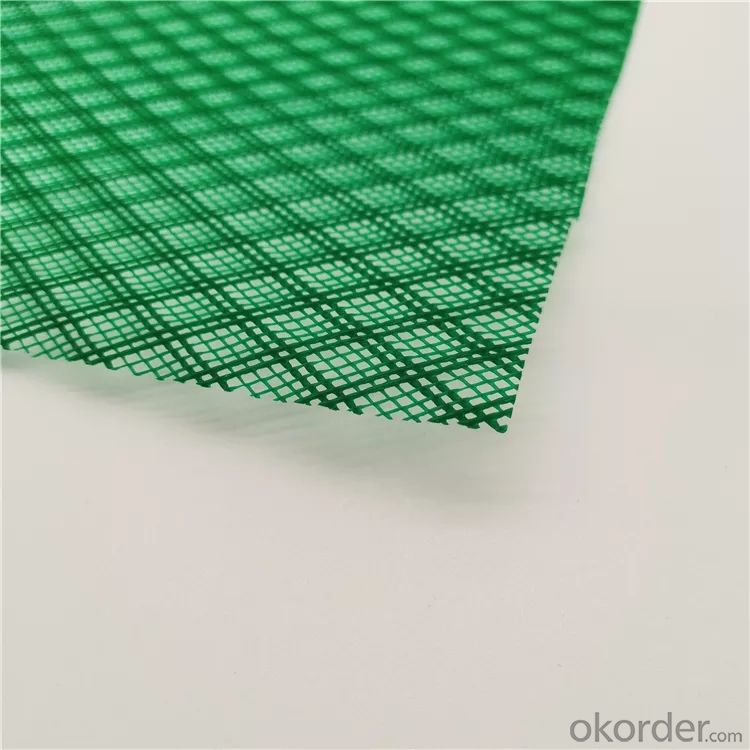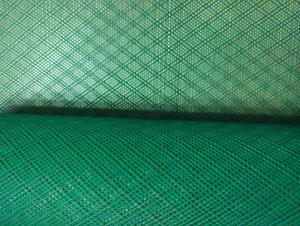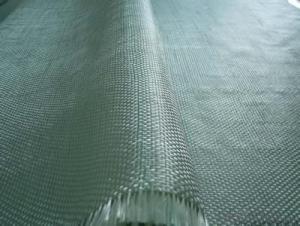Flow Media-vacuum infusion process fiberglass
- Loading Port:
- Shanghai
- Payment Terms:
- TT or LC
- Min Order Qty:
- 500 m²
- Supply Capability:
- 1000000 m²/month
OKorder Service Pledge
OKorder Financial Service
You Might Also Like
Flow Media
Product Description
Flow Media is a kind of resin drainage medium with low cost, which is widely used in vacuum infusion molding process. It can make resin permeate into any part of the products evenly and quickly. According to the different molding technology of products, it can be divided into two types: weaving type and extruding type. It has been proved that, extruding type can make workers easy to tile them without any curl. While regarding the weaving type, it is good for the flowing of air and resin because of its three-dimensional weaving structure. The demoulding effect is good and the cost is lower. Flow media mesh can be cut into any shapes. It is suitable for different shapes of products, with low consumption and good economic performance. It is widely applied to aerospace, wind-power blades, shipbuilding, racing, automotive, sports equipments and such composite manufacture industries.
Technique Data
Material: | PE |
Area Weight: | 110 g/m2 or 230g/m2 |
Width: | 120 cm |
Pattern: | Three-dimensional grid-like |
Temperature resistance: | 120℃ |
Color: | green |
Roll length: | 100 m |

- Q:Is fiberglass fabric resistant to UV discoloration?
- Yes, fiberglass fabric is generally resistant to UV discoloration.
- Q:How does fiberglass fabric compare to other types of fabrics?
- Fiberglass fabric has several unique characteristics that set it apart from other types of fabrics. Firstly, fiberglass fabric is extremely strong and durable. It has a high tensile strength and can withstand heavy loads and stress without tearing or stretching. This makes it an ideal choice for applications where strength and durability are crucial, such as in industrial settings or for outdoor equipment. Secondly, fiberglass fabric is highly resistant to heat and fire. It has a high melting point and does not catch fire easily, making it a suitable choice for applications where fire safety is a concern, such as in insulation materials or protective clothing. Additionally, fiberglass fabric is resistant to chemicals and corrosion. It does not react with most chemicals, acids, or alkalis, making it suitable for use in environments where exposure to corrosive substances is common, such as in chemical plants or laboratories. Furthermore, fiberglass fabric is lightweight and flexible. Despite its strength, it is not bulky or heavy, making it easy to handle and work with. This flexibility also allows for its use in various applications where a certain level of flexibility is required, such as in the construction of curved surfaces or in the manufacturing of composite materials. However, there are some drawbacks to fiberglass fabric. It is not as comfortable or soft as other types of fabrics, which can make it less appealing for certain applications, such as in clothing or upholstery. Additionally, fiberglass fabric can be more expensive compared to some other types of fabrics. Overall, fiberglass fabric is a highly versatile material that offers exceptional strength, durability, heat resistance, chemical resistance, and flexibility. While it may not be suitable for all applications, it is an excellent choice for those requiring the unique properties it possesses.
- Q:How does fiberglass fabric perform in flexural strength?
- Fiberglass fabric is known for its excellent flexural strength properties. Flexural strength refers to the ability of a material to withstand bending or flexing without breaking or deforming. Fiberglass fabric, which is made from fine glass fibers woven together, exhibits high flexural strength due to the inherent properties of glass. The glass fibers provide exceptional rigidity and resistance to bending forces, making fiberglass fabric highly durable and capable of withstanding significant flexing loads. The structure of fiberglass fabric allows it to distribute applied loads evenly across its surface, minimizing stress concentration points and preventing localized failure. This enables the material to maintain its shape and integrity even under substantial bending or flexing conditions. Moreover, the manufacturing process of fiberglass fabric allows for the orientation and arrangement of the glass fibers to be tailored, further enhancing its flexural strength. By strategically aligning the fibers, the fabric can be engineered to exhibit even greater resistance to bending forces in specific directions. Additionally, fiberglass fabric is often combined with resins or coatings to create composite materials, further improving its flexural strength. The resin matrix acts as a binder, providing additional support and stability to the glass fibers, enhancing the overall performance of the fabric. Overall, fiberglass fabric is renowned for its exceptional flexural strength, making it a preferred choice for applications that require high durability and resistance to bending or flexing forces.
- Q:Can fiberglass fabric be used for reinforcement in swimming pools?
- Yes, fiberglass fabric can be used for reinforcement in swimming pools. Fiberglass fabric is known for its high strength-to-weight ratio, durability, and resistance to corrosion and chemicals. These properties make it an ideal material for reinforcing swimming pools, where it can be used to reinforce the concrete or other materials used for the pool structure. The fiberglass fabric is typically applied as a layer between the layers of the pool material, such as the concrete, to provide added strength and structural integrity. It helps to prevent cracking, leaking, and other forms of damage that can occur over time. Additionally, fiberglass fabric is flexible and can be easily molded to fit the desired shape and contours of the pool, making it a versatile choice for pool reinforcement.
- Q:Can fiberglass fabrics be custom-designed or printed on?
- Yes, fiberglass fabrics can be custom-designed or printed on. Fiberglass fabrics are versatile and can be easily manipulated to suit specific design requirements. The printing process involves applying a design or pattern onto the fabric using various techniques such as screen printing, digital printing, or transfer printing. This allows for endless possibilities in terms of customization, including the incorporation of logos, images, or unique designs. Custom-designed or printed fiberglass fabrics are commonly used in industries such as fashion, interior design, automotive, and aerospace, where aesthetic appeal and branding are important factors.
- Q:What kind of fiberglass fabric and asphalt paint do you use for 5mm thick fiberglass?
- 5mm's best use of thick asphalt paint (crown card) with 0.4 mm glass fiber cloth, at least five cloth six oil, the cost is more expensive,
- Q:How does fiberglass fabric perform in corrosive environments in chemical plants?
- Fiberglass fabric is highly resistant to corrosion and performs exceptionally well in corrosive environments in chemical plants. Its non-reactive nature and excellent chemical resistance make it an ideal choice for protecting equipment and structures from the damaging effects of corrosive substances. Additionally, fiberglass fabric has a high tensile strength and is lightweight, making it easy to install and maintain. Overall, fiberglass fabric offers long-lasting durability and reliability in corrosive environments, ensuring the safety and efficiency of chemical plant operations.
- Q:How is fiberglass fabric stored and handled?
- Fiberglass fabric should be stored and handled with care to maintain its quality and prevent any damage. When it comes to storage, it is recommended to keep the fabric in a cool, dry place to avoid exposure to moisture or extreme temperature fluctuations. Ideally, it should be stored in a sealed bag or container to protect it from dust, dirt, and any potential contaminants. When handling fiberglass fabric, it is important to wear protective gloves to prevent any irritation or skin reactions. Additionally, wearing safety goggles or a face shield is recommended to protect the eyes from any loose fibers. During transportation or handling, it is advisable to avoid any sharp objects or rough surfaces that can cause tears or abrasions to the fabric. Care should be taken to avoid any unnecessary bending or folding, as this can lead to permanent creases or weak spots in the material. If the fabric needs to be cut or trimmed, it is recommended to use sharp scissors or a utility knife to ensure clean and precise cuts. It is also advisable to work in a well-ventilated area or wear a dust mask to minimize the inhalation of any loose fibers. In summary, fiberglass fabric should be stored in a clean and dry environment, handled with protective gear, and protected from any potential damage during transportation or cutting. By following these guidelines, the lifespan and quality of the fiberglass fabric can be preserved.
- Q:Can fiberglass fabric be used for insulation in telecommunications infrastructure?
- Fiberglass fabric is indeed a suitable option for insulation in telecommunications infrastructure. Its remarkable thermal insulation properties make it an optimal choice for insulating various components within the telecommunications industry. By effectively preventing heat loss or gain, it ensures that equipment functions within the desired temperature range. Moreover, fiberglass fabric's lightweight nature, flexibility, and easy installation process make it a convenient solution for insulating cables, antennas, and other infrastructure components. Additionally, its resistance to moisture, chemicals, and fire offers an extra layer of protection to the insulation system. All in all, fiberglass fabric is extensively utilized and considered an appropriate material for insulation in telecommunications infrastructure.
- Q:Can fiberglass fabric be used for reinforcement in boat hulls?
- Fiberglass fabric is indeed capable of reinforcing boat hulls. Its high strength-to-weight ratio, durability, and resistance to water and corrosion make it a popular choice for boat construction. Typically, fiberglass fabric is laid up in multiple layers and combined with a resin, such as polyester or epoxy, to create a composite structure. This composite material enhances the stiffness and strength of the hull, making it more resistant to impacts and flexing. In addition, fiberglass fabric can be easily molded into intricate shapes, allowing it to reinforce various parts of a boat hull. In conclusion, fiberglass fabric is a versatile and dependable option for reinforcing boat hulls, which explains its widespread use in the marine industry.
1. Manufacturer Overview |
|
|---|---|
| Location | |
| Year Established | |
| Annual Output Value | |
| Main Markets | |
| Company Certifications | |
2. Manufacturer Certificates |
|
|---|---|
| a) Certification Name | |
| Range | |
| Reference | |
| Validity Period | |
3. Manufacturer Capability |
|
|---|---|
| a)Trade Capacity | |
| Nearest Port | |
| Export Percentage | |
| No.of Employees in Trade Department | |
| Language Spoken: | |
| b)Factory Information | |
| Factory Size: | |
| No. of Production Lines | |
| Contract Manufacturing | |
| Product Price Range | |
Send your message to us
Flow Media-vacuum infusion process fiberglass
- Loading Port:
- Shanghai
- Payment Terms:
- TT or LC
- Min Order Qty:
- 500 m²
- Supply Capability:
- 1000000 m²/month
OKorder Service Pledge
OKorder Financial Service
Similar products
New products
Hot products
Hot Searches
Related keywords





























